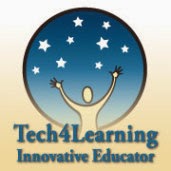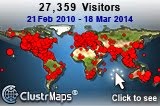- Intentional vagueness. Their positive connotations prevents questioning of intent.
- A desire to impress a judge, an examiner, an audience, or a readership, or to win an argument, through name-dropping of esoteric and poorly understood terms in an attempt to inflate trivial ideas to something of importance.
 |
| http://www.techwithintent.com/2012/06/iste-bingo-edtech-buzzwords/ |
One of these concepts, that is starting to feel like a buzzword to me, is "authentic audience." You've heard it. I've said it. Students used to turn in work to the teacher, the audience of one. But blogs, wikis and other tools have changed all that. Now our students can share their work with (say it with me) "an authentic global audience." Really?
There is no doubt that student's work MUST be authentic and that writing for real communication is highly motivating. Take blogging for example. Bloggers write to communicate, share and flesh out ideas. If the communication is one-way, learning may still occur. But without feedback and conversation, blogging is only slightly different than writing in a journal. If only the teacher reads and comments, how is blogging different than the "audience of one?"
What does this mean for student bloggers? What does it take to make the process truly authentic and truly interactive? I asked on Twitter but got no response...ironic? Or case in point?
Quality Work-
There are only so many people "out there" who want to read poorly written, lacking-in-passion posts with titles like "Journal #5." This poses a problem for teachers who are trying to embrace tools, but also looking for ways to structure writing assignments. Posting to a blog does not guarantee either student motivation or high quality work.
How much choice are students given in the assignment? How much teacher guidance goes into the final product? I don't propose a canned solution. Like most dilemmas in education, every teacher has to figure this out by asking, "What will work for each individual student in my class?"
Connected Teachers-
As teachers, we know the power of modeling. If we don't know or understand something, how can we teach it? Those teachers who, themselves, have the strongest networks are the most successful with connecting their students in all kinds of ways.
In my role, as teacher of teachers, it is not enough for me to set up blogs and teach the students and teachers to use them. If the teachers who assign the blog posts don't understand blogging in a deep, experiential way, the assignment is just that- a homework assignment.
Give and Take-
In a conversation we talk and listen. We ask questions and care about the answers. Talking to myself is not a conversation. In the edublogosphere are we guilty of talking too much and interacting too little? How many bloggers leave regular comments for others? How many teachers who tweet and share the work of their own students, seeking comments and feedback from others, take the time to respond when someone else asks?
Are we teaching our students to read the posts of other students? Are we taking the time to model and teach quality commenting? Are we assigning students to interact with others or just to write their own posts? Are we, as teachers, taking responsibility to mentor and interact with students other than our own?
Writing with the Audience in Mind-
One thing that I have noticed over and over again, with students of all ages is the way they end a story or video or other project with the words, "I hope you like it" or "I hope you enjoy my story." They ARE innately creating with an audience in mind. And they want the audience to connect with their work. But we know that it's not enough to hope. We have to learn to use our words and images in ways that draw the attention we seek. We need to teach our students good writing, and good writing has a purpose and an audience in mind.
Digital Literacy-
Digital writing is different. I am still learning this myself, as I know I am too wordy. In high school and college I wasn't wordy enough and had to force myself to say more to fill x pages or words to fulfill the assignment. The jury is still out on whether the Internet is making us shallower, but there is little doubt that our eyes are not drawn to endless lines of text on the digital page. Are we teaching students to use bullet points, subtitles and images? Are we teaching them to write succinctly and powerfully?
Humility-
One of the parents at our school brought up the issue of humility. I thought it was an astute observation- that so much of online behavior is attention-seeking. We post something on Facebook because we hope it will be liked. We are excited for the "success" of a video gone viral. Is this the right measuring stick for work of meaning and depth, work that shows quality and growth? How do we help students develop positive character values, such as patience and humility, in this instant, connected world?
These are just a few points to consider. What have I forgotten?

+on+Twitter.jpg)









